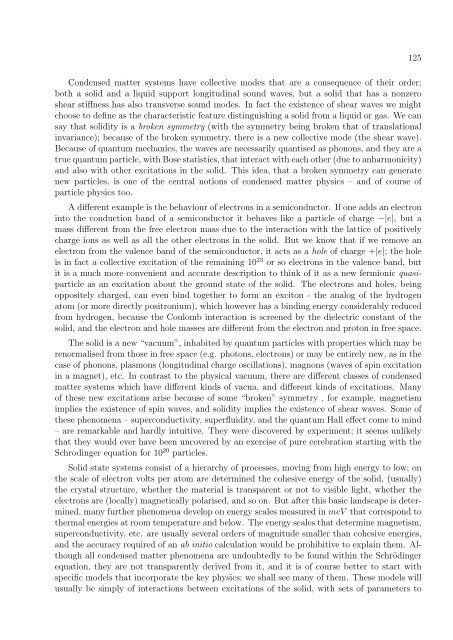Set of supplementary notes.
Set of supplementary notes.
Set of supplementary notes.
You also want an ePaper? Increase the reach of your titles
YUMPU automatically turns print PDFs into web optimized ePapers that Google loves.
Condensed matter systems have collective modes that are a consequence <strong>of</strong> their order;<br />
both a solid and a liquid support longitudinal sound waves, but a solid that has a nonzero<br />
shear stiffness has also transverse sound modes. In fact the existence <strong>of</strong> shear waves we might<br />
choose to define as the characteristic feature distinguishing a solid from a liquid or gas. We can<br />
say that solidity is a broken symmetry (with the symmetry being broken that <strong>of</strong> translational<br />
invariance); because <strong>of</strong> the broken symmetry, there is a new collective mode (the shear wave).<br />
Because <strong>of</strong> quantum mechanics, the waves are necessarily quantised as phonons, and they are a<br />
true quantum particle, with Bose statistics, that interact with each other (due to anharmonicity)<br />
and also with other excitations in the solid. This idea, that a broken symmetry can generate<br />
new particles, is one <strong>of</strong> the central notions <strong>of</strong> condensed matter physics – and <strong>of</strong> course <strong>of</strong><br />
particle physics too.<br />
A different example is the behaviour <strong>of</strong> electrons in a semiconductor. If one adds an electron<br />
into the conduction band <strong>of</strong> a semiconductor it behaves like a particle <strong>of</strong> charge −|e|, but a<br />
mass different from the free electron mass due to the interaction with the lattice <strong>of</strong> positively<br />
charge ions as well as all the other electrons in the solid. But we know that if we remove an<br />
electron from the valence band <strong>of</strong> the semiconductor, it acts as a hole <strong>of</strong> charge +|e|; the hole<br />
is in fact a collective excitation <strong>of</strong> the remaining 10 23 or so electrons in the valence band, but<br />
it is a much more convenient and accurate description to think <strong>of</strong> it as a new fermionic quasiparticle<br />
as an excitation about the ground state <strong>of</strong> the solid. The electrons and holes, being<br />
oppositely charged, can even bind together to form an exciton - the analog <strong>of</strong> the hydrogen<br />
atom (or more directly positronium), which however has a binding energy considerably reduced<br />
from hydrogen, because the Coulomb interaction is screened by the dielectric constant <strong>of</strong> the<br />
solid, and the electron and hole masses are different from the electron and proton in free space.<br />
The solid is a new “vacuum”, inhabited by quantum particles with properties which may be<br />
renormalised from those in free space (e.g. photons, electrons) or may be entirely new, as in the<br />
case <strong>of</strong> phonons, plasmons (longitudinal charge oscillations), magnons (waves <strong>of</strong> spin excitation<br />
in a magnet), etc. In contrast to the physical vacuum, there are different classes <strong>of</strong> condensed<br />
matter systems which have different kinds <strong>of</strong> vacua, and different kinds <strong>of</strong> excitations. Many<br />
<strong>of</strong> these new excitations arise because <strong>of</strong> some “broken” symmetry , for example, magnetism<br />
implies the existence <strong>of</strong> spin waves, and solidity implies the existence <strong>of</strong> shear waves. Some <strong>of</strong><br />
these phenomena – superconductivity, superfluidity, and the quantum Hall effect come to mind<br />
– are remarkable and hardly intuitive. They were discovered by experiment; it seems unlikely<br />
that they would ever have been uncovered by an exercise <strong>of</strong> pure cerebration starting with the<br />
Schrodinger equation for 10 20 particles.<br />
Solid state systems consist <strong>of</strong> a hierarchy <strong>of</strong> processes, moving from high energy to low; on<br />
the scale <strong>of</strong> electron volts per atom are determined the cohesive energy <strong>of</strong> the solid, (usually)<br />
the crystal structure, whether the material is transparent or not to visible light, whether the<br />
electrons are (locally) magnetically polarised, and so on. But after this basic landscape is determined,<br />
many further phenomena develop on energy scales measured in meV that correspond to<br />
thermal energies at room temperature and below. The energy scales that determine magnetism,<br />
superconductivity, etc. are usually several orders <strong>of</strong> magnitude smaller than cohesive energies,<br />
and the accuracy required <strong>of</strong> an ab initio calculation would be prohibitive to explain them. Although<br />
all condensed matter phenomena are undoubtedly to be found within the Schrödinger<br />
equation, they are not transparently derived from it, and it is <strong>of</strong> course better to start with<br />
specific models that incorporate the key physics; we shall see many <strong>of</strong> them. These models will<br />
usually be simply <strong>of</strong> interactions between excitations <strong>of</strong> the solid, with sets <strong>of</strong> parameters to<br />
125








